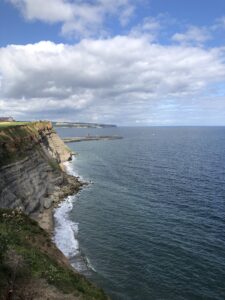
Site visits are an important part of my writing research, because being where my characters’ experiences occurred gives me a greater sense of closeness to their lives. My most recent book, Saxon Heroines, took me back to Whitby Abbey where I videoed waves pounding on the headland.

When writing Rama’s Labyrinth, I visited Mukti Mission founded by Pandita Ramabai near Pune, India. Two Coins took me back to India, this time to Kolkata where I visited the court house where Mary Pigot’s civil case against Rev. William Hastie was tried before Judge Norris.
Researching my current project about the Crowninshield and Derby families in the 18th century took me to Salem, Massachusetts where both families made and lost their fortunes. Today Salem is most well-known for the 1692 witchcraft trials. The association draws tourists throughout the year, but particularly at Halloween. To a lesser extent, the city is also famous for the heyday of commercial voyages to the East Indies.
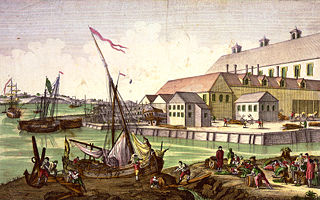
By 1790, Salem was the 6th largest city in the new United States, and a world famous seaport with a large cod fishing industry. Merchants shipped dried cod and timber to Europe and the West Indies, and exchanged sugar and molasses in the West Indies; tea from China and India; and pepper from Sumatra.
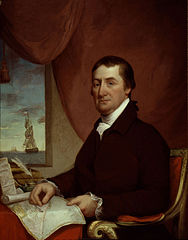
The wealthiest merchant in Salem was Elias Hasket Derby who made his fortune, first, on extensive success sponsoring privateers against the British during the American Revolution, and second, on the East Indian Trade. Though he never went to sea himself, Derby trans-shipped goods throughout the world. He was one of the first merchants to trade with St. Petersburg, and had extensive trading contacts in the East Indies. When he died in 1800, it became clear that Elias Hasket Derby was the first American millionaire.
Though the East India Trade faded after 1820, when Salem created its city seal in 1839, the motto was Divitis Indian usage ad ultimatum sinum [To the Rich East Indies Until the Last Lap.]
Salem is filled with historic homes, many with identifying plaques. The Chestnut Street District is part of the Samuel McIntire History District with 407 buildings, and the Salem Maritime National Historic Site comprised of 12 historic structures and a replica of a tall ship on 9 acres of waterfront land. There is also an area called the Derby Waterfront District which runs east to a junction with Fort Avenue.
Salem Maritime National Historic Site
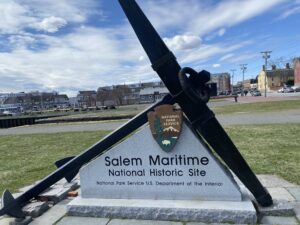
The Maritime Historic Site, established in 1938, was the first National Historic Site in the United States. Derby Wharf is a key feature of the site, and was an important pathway for me as I walked facing forward on a sunny day with a chilly wind. Facing the sea, I looked left where Union Wharf once stood. Unlike Derby Wharf, Union Wharf, established by the Crowninshield family, is nothing but a memory in time. Looking right, I saw remnants of the Central Wharf, first built in 1784.
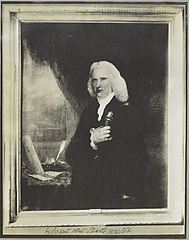
Richard Derby began building an 800-foot wharf in 1762. Workers laid timbers on the mud flats when the tide was out and filled in the timber walls with dirt and stones. In 1770, the wharf was complete. Up to twenty of Elias Hasket Derby’s warehouses, including his Counting House, lined the wharf; his massive trading vessels were moored by its side.
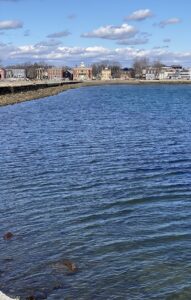
From the end of the 800-foot wharf, Elias Hasket Derby could turn to face the shore and his house situated directly across from the wharf’s entrance. The photo on the right is a bit long, but it gives a sense of the length of the wharf. Just under the cloud is a structure with a white dome. Derby’s house is to the left. [More about Derby House in the next blog.]
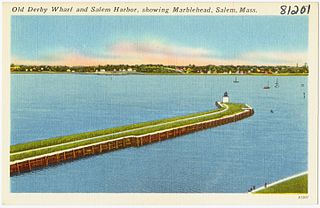
Six years after Hasket died in 1800, his heirs extended the wharf another 1300 feet. Today there is only one structure by the wharf, the Pedrick Store House, once used as a warehouse and sail loft. There is also one ship, a replica of 1797 Ship Friendship that made 15 voyages to ports in Batavia, India, China, South America, the Caribbean, England, Germany, the Mediterranean, and Russia before being captured by the British during the War of 1812. The replica was constructed in 2000, and sits in lonely isolation beside the historic wharf.
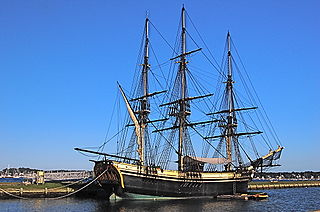
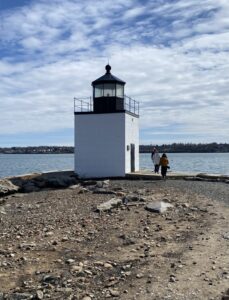
The 0.38 mile pathway to the end of Derby Wharf is now called the Derby Wharf National Recreation Trail. It’s a good name, though it sounds more impressive than the walk is. The Derby Light Station, first lit in 1871, still stands at the end of the trail marking the main channel to the harbor anchorage. The 300-candlepower solar-driven light flashes red every six seconds.
It sounds strange, but walking the length of Derby Wharf, feeling the constant wind, and imagining what once stood on the site brought me closer to my characters, helping me imagine them as they might have been.
⛵️ ⛵️ ⛵️
Illustrations
Salem Shipping 1770.
Elias Hasket Derby by James Frothingham, about 1800.
Capt Richard Derby by Henry Sargent, about 1790.
Old Derby Wharf & Salem Harbor, postcard, c.1930.
Additional Photos by Author.
Salem Maritime National Historic Site. National Park Service.

Sandra Wagner-Wright holds the doctoral degree in history and taught women’s and global history at the University of Hawai`i. Sandra travels for her research, most recently to Salem, Massachusetts, the setting of her new Salem Stories series. She also enjoys traveling for new experiences. Recent trips include Antarctica and a river cruise on the Rhine from Amsterdam to Basel.
Sandra particularly likes writing about strong women who make a difference. She lives in Hilo, Hawai`i with her family and writes a blog relating to history, travel, and the idiosyncrasies of life.


Nice
Hi Leslie – so glad you enjoyed my blog